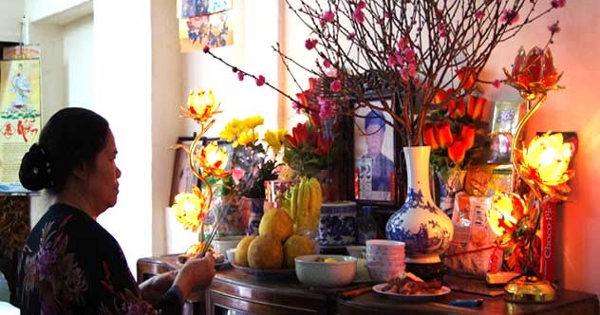How do Vietnamese families decorate ancestral altar during Tet?
VOV.VN - It is common for Vietnamese people to go through an important ritual of cleaning and decorating the ancestral altar in their home ahead of the Lunar New Year, known locally as Tet.

Worshiping ancestors is a traditional ritual that has been part of local culture for centuries. Indeed, it is the way people show their respect for the dead, with many believing that when the ritual is done they are blessed with excellent health, happiness, and prosperity.
Ancestor worship often takes place on special occasions throughout the year, for example on the first or 15th days of each lunar month, or on the death anniversary of deceased family members. On these days, it is normal for people to prepare a tray of fruit, various dishes, and votive papers, all of which are placed on the altar whilst incense burns as an offering to the ancestors.
Several days ahead of Tet, local people traditionally go to the cemetery in order to pay homage to the dead. On New Year’s Eve, they tend to prepare a large feast together with other offerings such as fruit, flowers, and sweets to their ancestors. It is therefore typical for the end-of-year party to be attended by all members of the family.
Followers of Feng Shui believe that good preparations bring about good luck. When cleaning the altar, it is thought that home owners should not arbitrarily move the incense urn, as this could represent a bad omen for the family in the New Year.
It is worth remembering that after removing the old incense sticks, the home owner should not pour out the ashes from the incense urn, because such an act is said to throw away happiness, health, and success. Instead, the owner should use a small spoon in order to gradually scoop the ashes out of the urn.

A tray of fruit is an indispensable item found on the altar of every family during Tet. Depending on the customs of each region, residents choose different varieties of fruit. For example, northerners usually prefer bananas, apples, oranges, a pomelo, peaches, papayas, and chilies to display on the altar.
Furthermore, people from northern regions tend to place a bunch of green bananas at the bottom of the tray, symbolising the gathering of descendants. However, this kind of fruit is never used by southerners who believe that bananas always bring bad luck. Instead, they often prepare five kinds of fruit, namely custard apples, figs, coconuts, papayas, and mangoes.
Elsewhere, people from the central region do not care about what kind of fruits are displayed on the altar as for them the most important aspect of the ritual is to respect their ancestors.
Moreover, it is the habit of many families to display artificial flowers made of paper, plastic, silk, or other materials on the altar, for economic reasons. However, followers of Feng Shui point out that displaying artificial flowers does not mean respecting ancestors.
According to traditional beliefs, fresh and long-lasting flowers such as lilies, yellow chrysanthemums, a branch of apricot, or peach blossoms should be used to decorate the altar during the Tet holiday.

